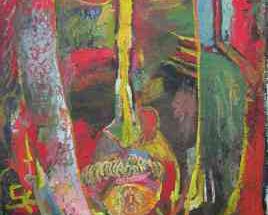

Eric Cadien attended the ‘art school’ during the dynamic seventies when self- reliance and self-determination became the political watch-words that guided Jamaica beyond independence towards self-government and Democratic Socialism.
At the Jamaica School of Art Jerry Craig and Hope Brooks taught him, but his earliest influences in terms of style and technical development came from artists such as Winston Patrick and Osmond Watson and Kofi Kayiga.
He was initially trained as a sculptor but after returning from post-graduate studies in Canada he began to create paintings that with bold colour, clearly defined forms and self-conscious use of spatial relationships. He brought a fresh approach to Jamaican composition.
Cadien’s work was informed by expressionist artists of a slightly older generation like Karl Parboosingh and Eugene Hyde and Kofi Kayiga. He fostered their interest in abstraction and combined it with iconography then current in Rastafarian circles. The result was imagery that paid homage to European modern art but was more deeply rooted in black nationalism. In the last years of his life he reveled in the 2D surface, his work became more representational and the figure as nude, musician, kings and queens, created a pantheon of images rooted African and Jamaican symbolism. His work would set a precedent for those students he later tutored in experimental painting and sculpture at the Jamaica School of Art such as Omari Ra/Robert Cookhorne, Kalfani Ra/Douglas Wallace, and Stanford Watson.
Cadien was too young to completely identify with the concerns of Jamaica’s earliest abstract painters, neither was he a part of that later group of Expressionist painters of the eighties labelled ‘new imagists’. The arrested development of his oeuvre due to his untimely death has allowed others to view him as an artist who bridged the two movements in the development Jamaica’s modern art. But, Cadien’s own thoughts about creativity and his paintings exhibited just prior to his death suggest that his work was still in transition and not limited to any school or style. He wrote: ‘A consistent artist is a thoughtless one, because he conforms to a style; he repeats himself and thinks in a groove. The artist must always try to understand himself, and understanding cannot come through conformity, but through self -knowledge which is always new.’
He was unfortunely killed at the peak of his career in 1993.
www.wiki.answers.com/Q/Who_is_Eric_Cadien#ixzz1Cd3fE2JQ
